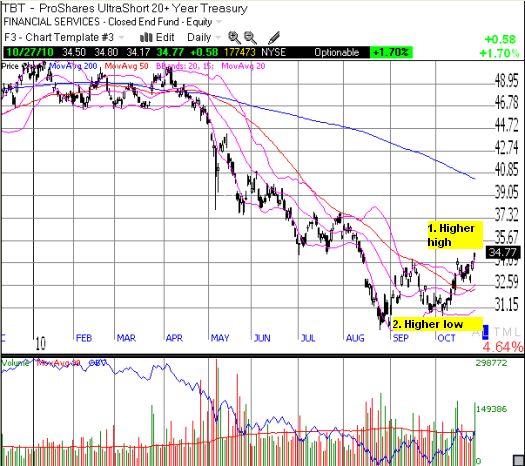Bloomberg summarized the latest missive from Bill Gross in a piece called “Fed Easing to Signify End of Bull Market, Gross Says.” Gross called an end to the 30-year bull market in bonds thanks to the the Federal Reserve’s planned second round of quantitative easing. I decided to read Gross in his own words, and I recommend you do the same – especially given that it seems the market is slowly turning to deliver on Gross’ prediction. At the end of this piece, I post a chart of TBT, the ProShares UltraShort 20+ Year Treasury, that suggests a bottoming process is underway (a topping process for long-dated Treasuries).
After reading “Run Turkey, Run” for myself, I learned that Gross is reiterating an earlier call for a top in bonds. He is also quite critical of the entire political system’s inability to solve fundamental, core problems with the economy.
Here are the quotes that most interested me:
First, Gross expressed the disappointment I think many Americans, like myself, feel in our political system:
“Democrat or Republican, Elephant or Donkey, nothing much ever seems to change. Each party has shown it can add hundreds of billions of dollars to the national debt with little to show for it or move our military from one country to the next chasing phantoms instead of focusing on more serious problems back home. This isn’t a choice between chocolate and vanilla folks, it’s all rocky road: a few marshmallows to get you excited before the election, but with a lot of nuts to ruin the aftermath.”
(Note I have recently come around to consider the possibility that some government stimulus spending stabilized the economy and saved it from worse fates).
Next, Gross noted the difficulty of allowing the economy to reset itself from a lower level. It is a painful process that the Federal Reserve is resisting with the few tools it has left:
“Perhaps, as a vocal contingent suggests, our paper-based foundation of wealth deserves to be buried, making a fresh start from admittedly lower levels. The Fed, on Wednesday, however, will decide that it is better to keep the patient on life support with an adrenaline injection and a following morphine drip than to risk its demise and ultimate rebirth in another form.”
I was quite taken aback when Gross directly compared government debt to a Ponzi scheme. I have long agreed with this viewpoint, but I did not think one of the largest buyers in this scheme would so bluntly make the case. Moreover, Gross appears to expect an inflationary outcome from the next phase of quantitative easing:
“Check writing in the trillions is not a bondholder’s friend; it is in fact inflationary, and, if truth be told, somewhat of a Ponzi scheme. Public debt, actually, has always had a Ponzi-like characteristic. Granted, the U.S. has, at times, paid down its national debt, but there was always the assumption that as long as creditors could be found to roll over existing loans – and buy new ones – the game could keep going forever. Sovereign countries have always implicitly acknowledged that the existing debt would never be paid off because they would ‘grow’ their way out of the apparent predicament, allowing future’s prosperity to continually pay for today’s finance.”
Gross goes on the blame the political system AND its voters (including himself) for bringing the country to this point:
“The Fed, in effect, is telling the markets not to worry about our fiscal deficits, it will be the buyer of first and perhaps last resort. There is no need – as with Charles Ponzi – to find an increasing amount of future gullibles, they will just write the check themselves. I ask you: Has there ever been a Ponzi scheme so brazen? There has not. This one is so unique that it requires a new name. I call it a Sammy scheme, in honor of Uncle Sam and the politicians (as well as its citizens) who have brought us to this critical moment in time. It is not a Bernanke scheme, because this is his only alternative and he shares no responsibility for its origin. It is a Sammy scheme – you and I, and the politicians that we elect every two years – deserve all the blame.”
The solution that Gross offers (through PIMCO) to investors amounts to dollar flight. All but one of the elements of his “safe spread” involve taking dollars offshore. This flight for yield is one of several mechanisms that will likely limit the effectiveness of printing more money: some notable amount of it will effectively go to work in overseas investment that will do little for stoking domestic demand (or jobs).
“Interest rates may be rock bottom, but there are other ways – what we call ‘safe spread’ ways –to beat the axe without taking a lot of risk: developing/emerging market debt with higher yields and non-dollar denominations is one way; high quality global corporate bonds are another. Even U.S. Agency mortgages yielding 200 basis points more than those 1% Treasuries, qualify as ‘safe spreads.’ While our ‘safe spread’ terminology offers no guarantees, it is designed to let you sleep at night with less interest rate volatility.”
(I think only Bill Gross can still get away with attaching the word “safe” to any investment in this environment!)
In the meantime TBT, the inverse ETF betting against the 20+ year Treasury, seems to have finally started the process of some kind of bottom. For the first time in 2010, TBT has made higher lows and higher highs:

Moreover, for two weeks, the dollar index has managed to hold the support line that many now watch with great anticipation:

*All charts created using TeleChart:

Overall, as the country careens into next week’s momentous election and Federal Reserve meeting (and do not forget the next employment report!), it seems that the market is preparing to surprise us with its reaction.
Be careful out there!
Full disclosure: Long TBT
